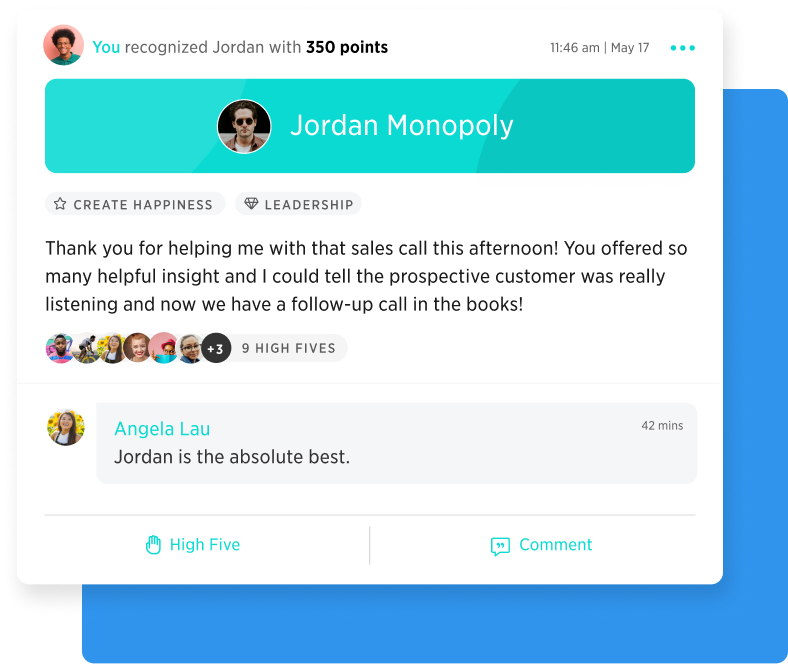Table of Contents
As we navigate The Great Resignation, it’s no secret the pressure’s on for HR leaders to strategize how to retain their diverse talent. And with Black employees and women leaving jobs at much higher rates than their white counterparts in 2021, the challenge has crystallized. How can companies committed to diversity, equity, and inclusion (DE&I) retain this talent?
Employees leaving? Check out the other pieces in our employee retention series:
- 9 Employee Retention Strategies to Retain Top Talent
- Need to Keep Employees From Quitting? Start Recognizing Them
- The Manager’s Role in the Great Resignation
- 6 Employee Success Tips to Boost Employee Retention
- 20 Ways to Boost Employee Morale and Prevent Burnout
- The Employee Experience that Cuts Quit Rate in Half
The hard truth about diversity & employee turnover
While DE&I is not a new initiative for most organizations, retaining people from underrepresented groups has become harder than ever. According to a recent report from the Center for Talent Innovation, more than one-third of Black employees plan to look for a new job in the next two years. That number is 30% higher than it is for their white colleagues.
On the gender front, the pandemic has disproportionately impacted women, who are also leaving their jobs in mass numbers — or in some cases, leaving the workforce altogether. The culprit? The need (still overwhelmingly placed on women) to care for children as daycares have closed and schools have converted to remote learning.
This means, in the midst of a tremendous talent migration, workplaces are not only at risk of losing their best people. They’re also at risk of losing the benefits a diverse set of people brings to the table: unique perspectives, better collective problem-solving, and innovative ideas.
Workplaces are not only at risk of losing their best people. They’re also at risk of losing the benefits a diverse set of employees brings to the table: unique perspectives, better collective problem-solving, and innovative ideas.
The truth is, an employee experience will never be truly great until it’s great for everybody. And not just on paper, but in real, lived experience. So, if you’re wondering about how to triage needs in the face of the Great Resignation, DE&I should top your list.
The business case for workplace diversity and retention strategies
Companies that represent gender, ethnic, racial, age, and ability diversity:
- find connection points with end users more easily
- find creative solutions more quickly
- retain workers longer
They’re also 6X as likely to be innovative, and have 2.3x greater per employee cash flow than companies with lower diversity scores. Executive teams in the top quartile for gender diversity are 25% more likely to have above average profitability than those in the bottom quartile.
And yet.
Only 40% of all professionals say that their organization’s diversity, equity, and inclusion efforts are adequate. Black professionals are 30% more likely to intend to leave than their white counterparts, with 1/3 of Black workers planning to leave their current company in the next two years.
Meanwhile, top-level female leaders are resigning in epidemic numbers. A recent study estimated that by 2027, we will have lost 20% of female C-suite leadership. The same study revealed that women in management (at any level) leave their jobs at twice the rate of men.
Diverse Talent retention and intersectionality
The stakes are highest where gender and race intersect, especially for Black women. According to the Philanthropy News Digest, Black women feel less supported by managers than men, white women, Latinas, or Asian-American women. Here’s a breakdown:
- 29% of Black women feel their manager advocates for new opportunities for them
- 36% feel their manager gives them opportunities to manage people and projects
- 22% feel their manager helps them manage their career path
Black women also report being “far more likely” to experience daily discrimination than men or other women.
As we look at the data, a grim picture emerges in terms of the experience people from minority groups are having in many workplaces. So let’s look at some solutions.
How to retain diverse talent
1. Assess your current state
It’s hard to know where to go without understanding where you currently stand.
If you’re an HR leader, first recognize that your perception of your DE&I program may or may not align with the real, lived experiences of your diverse team members. Finding a way forward involves gathering real data from your company, and measuring and tracking it over time.
Need help? We’ve got you covered. Check out our article, How to Measure the Success of Your DE&I Program, which includes DE&I worksheets. Ready for DE&I surveys? Our Surveys & Insights solution will have you up-and-running in no time.
2. Implement inclusive hiring and recruiting practices
Get new hires started off right at your organization. In truth, a new employee’s experience with your organization begins before day 1, during recruiting and hiring. Do a strategic analysis of your organization’s hiring materials and process to ensure not only that you’re attracting diverse candidates, but that you’re signaling that your workplace will be a supportive, inclusive one once they arrive. Action steps include:
Work with your web and marketing team on your careers webpage
Identify the key stakeholders in your careers webpage (likely a combination of your HR team, the marketing team, and your web or IT team) to do an audit of what’s there. If there are photos, do they display a diverse workforce? Are your organization’s values listed, and if so, do they include inclusivity? Does your hiring mission statement welcome diversity?
Remember, this page serves as a welcome mat for all new talent. Make sure it gives the right message.
Neutralize job descriptions
Do your job descriptions contain gender-biased language, like “competitive and driven” (which traditionally attract men) versus “cooperation and teamwork” (which traditionally attract women?) Learn more about how to neutralize job descriptions from Glassdoor, and see how we’ve done it ourselves here at WorkTango.
Implement blind resumes and withhold social media checks
Ask for resumes without photos of candidates. And when you pass them on to hiring managers, consider removing information such as name and education to reduce gender and socioeconomic bias. In addition, withhold social media checks prior to the first interview. This helps introduce an anti-bias stance into hiring from the get-go, which sets your candidates up for success throughout their journey with you.
Use skills tests in hiring
Rather than relying solely on education or past experience (which are not available to all candidates), give candidates skills tests to assess their fit for the job.
3. Build inclusivity into onboarding
Your updated hiring practices pave the way for more diverse candidates to both feel safe interviewing with you, and as well as overcome barriers to be successfully hired. Now, set them up for success and ensure they feel welcome from day 1. Here are some tips from our Roadmap to End Unconscious Bias in the Workplace:
Give value-centric introductions
When introducing a new employee to the team, lead not with their education or hometown, but with what value you feel this person will add to the team. This frames them as a valuable contributor, both to the team, and to the organization. Most critically, it helps nip in the bud any assumptions that the person was hired for any reason other than their unique ability, experience, and strengths (think: being a “diversity hire”). Train your hiring managers to do the same.
Facilitate regular social events
Make sure new hires mix and mingle with current employees in settings outside the workplace. This helps everyone build belonging and connectedness. Genuine social bonds are critical for helping new hires feel included. They’re also key for folks getting to know their colleagues as complex people with lives and shared values, rather than shallow, surface-level names and faces.
Develop onboarding buddy and mentorship programs
Another way to rapidly develop meaningful social bonds — and invest in professional development for diverse talent — is to pair new hires with onboarding buddies (often peers on their teams or other teams) or mentors (generally senior employees and leadership).
One of the biggest barriers to promotion and career development for diverse talent is a lack of connection with leadership — especially senior leadership. Work to arrange and encourage sponsorships, mentorships, and chances to interact from the get-go. Document these connections so you can track progress toward equity.
4. Build DE&I into your performance review processes
Want to keep diverse talent? Make sure they’re receiving fair opportunities to grow and develop at your organization. One of the biggest bias pain points? Performance reviews, which are notoriously prone to recency bias and personal bias by the reviewing manager.
The stakes here are obviously high. Employee growth and development opportunities — not to mention promotions and raises — hinge heavily on these quarterly reviews. So make it a priority to remove bias from them. How?
Meet the talent review. As we explain in the article linked below, the talent review is the conversation that takes place before the performance review (Check-In). The talent review conversation mitigates bias by looping in more voices than just the manager’s. It’s a conversation between your HR team, the manager, and leadership. Critically, they’re fact-based, with guiding questions that lead managers to justify the ratings they’ve given each team member using data and examples, rather than just impressions and anecdotal memories.
5. Emphasize inclusivity at the management and leadership levels
As stated above, only 29% of Black women feel their managers advocate for them. The tl;dr? You can run inclusion events all year long, but if managers and leadership don’t model and practice inclusive behavior, you’re letting your diverse talent down in a big way — and they’ll start looking for the exit. Make sure management and leadership are fully versed in DE&I ethics. (And also that your leadership team reflects the diversity your company preaches.)
6. Focus on inclusion, not just diversity
We can’t emphasize this enough: Diversity in itself isn’t a high enough goal, and optimizing for diversity won’t ensure your organization retains diverse talent. You must make a concerted effort to create a psychologically safe workplace that’s genuinely welcoming–where all employees feel comfortable expressing ideas, taking risks, and making the mistakes that lead to personal growth and professional innovation. You need true belonging.
7. Make everyone feel appreciated with regular recognition
Here’s your quickest talent retention win on the list: Celebrate all people including your diverse talent, meaningfully and regularly. A full 79% of employees who leave their jobs cite lack of appreciation as a reason. So if your organization’s turnover is high, especially among diverse talent, fix it by making employee recognition easy to share across the organization.
Pro tip: Make employee recognition easy to share
Ease is critical. The harder something is to do (even if it’s satisfying), the harder it’ll be to make it a key cornerstone of your culture. Optimize with a Recognition & Rewards solution that makes recognition social (e.g., viewable organization wide), simple to share, and tied to your company values.
Bonus: Empower your team with an Employee Experience Platform that makes sharing Recognition & Rewards easy and equitable.
Pro tip: Offer peer-to-peer employee recognition
Most importantly, make sure your program allows for peer-to-peer employee recognition. Traditional manager-to-employee recognition programs lead to less overall recognition being shared. It also tends to create a sense that the recognition may be obligatory or less authentic. When employees are empowered to celebrate each other, you introduce more avenues for building connection and for belonging.

8. Make your workplace holiday calendar inclusive
Want another quick win? Expand your organization’s holiday calendar. As we note in our article, 15 Tips for Building a More Inclusive Workplace, for underrepresented groups in the workplace, even small instances of inclusion can make a world of difference.
So make sure your organization’s holiday calendar doesn’t just include national and Christian holidays, but also holidays that represent the beliefs of your entire workforce. If your calendar includes Christmas and Easter, be sure it also includes the Jewish High Holy Days of Rosh Hashanah and Yom Kippur. For Muslims, include Eid and Ramadan, and for Hindu employees, include Diwali and Navrati.
Even if you can’t include these as paid holidays, make sure they appear on the calendar. And check out our Workplace Diversity and Inclusivity Calendar for more holidays and observances.
9. Offer benefits that support your people
If you aren’t thinking strategically about your benefits, you’re missing a major opportunity to create the kind of inclusive workplace that will retain diverse talent.
As we note in our article How to Make Employee Incentive Programs Actually Effective, take a hard look at the benefits you offer, vs. what your people actually need. For example, want to retain women in your workforce? Examine your parental leave and daycare benefits. Look at your work-from-home and flexible scheduling options. These can make major differences in whether people with caregiving responsibilities can stick with you or need to find work elsewhere.
10. Offer meaningful employee rewards
Employee rewards are often stocked with generic products and company-branded swag. Instead, take advantage of your employee rewards program to create inclusivity by offering rewards that matter.
Need some examples?
- Support parents in your workforce by adding grocery delivery and TaskRabbit vouchers to your custom rewards catalog
- Help prevent burnout for diverse employees by offering rewards for mental health days and other mental health boosters
- Give back with reward donations to nonprofits and social causes of your employees’ choosing
Retain diverse talent with WorkTango
We’re serious about building world-class employee experiences — for everyone. Ready to join us?



